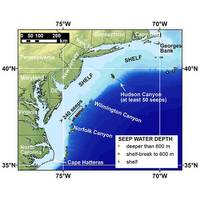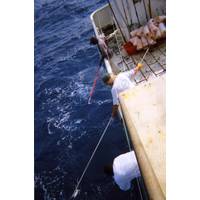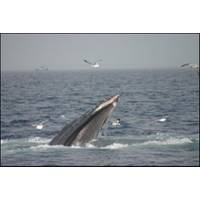Critical Habitat for Endangered North Atlantic Right Whale
Using new information not previously available, NOAA Fisheries is expanding critical habitat for endangered North Atlantic right whales to cover its northeast feeding areas in the Gulf of Maine/Georges Bank region and southeast calving grounds from North Carolina to Florida. This final rule, which was initially proposed in February 2015 and received 261 general comments over a 60-day comment period, does not include any new restrictions or management measures for commercial fishing operations. This rule is based on 35 years of aircraft and ship borne surveys of right whale distribution, and

Study Reveals US Atlantic Margin Methane Seep Expansion
University researchers, the U.S. Geological Survey and other institutions, reveals that the natural methane leakage from the U.S. Atlantic margin seafloor extends beyond prior knowledge gathered on the issue. Methane plumes identified in the water column between Cape Hatteras, North Carolina and Georges Bank, Massachusetts, are emanating from at least 570 seafloor cold seeps on the outer continental shelf and the continental slope. Taken together, these areas, which lie between the coastline and the deep ocean, constitute the continental margin. Prior to this study, only three seep

Tuna Study Uses New Tracking Methods
study of bigeye tuna movements in the northwestern Atlantic Ocean led by Molly Lutcavage, director of the Large Pelagics Research Center at the University of Massachusetts Amherst, found among other things that these fish cover a wide geographical range with pronounced north-south movements from Georges Bank to the Brazilian shelf, and they favor a high-use area off Cape Hatteras southwest of Bermuda for foraging. This NOAA-funded research, which used a new approach to study one of the most important commercial tuna species in the Atlantic, provides the longest available fishery-independent record

Humpback Whales Feed in Different Ways Finds NOAA
side-roll inversions, and repetitive scooping. A recently published paper, in the journal Marine Mammal Science, indicates that bottom side-roll techniques are common in Stellwagen Bank National Marine Sanctuary and the Great South Channel study area, a deep-water passage between Nantucket, Mass. and Georges Bank-further southeast.The study further states that the observed feeding behavior also leads to vulnerability to entanglement in bottom set fishing gear, an issue which is a major mortality factor for the species. This finding reaffirms a NOAA Fisheries regulation that mandates the use of sinking

New England
is the town of Gloucester. The town sits on Cape Ann and this popular summer destination is quintessential New England. It was originally founded in 1623 and is one of the earliest English settlements. In its earlier days it was an important shipbuilding center, and to this day due to its proximity to Georges Bank, it remains one of the most important fishing ports in the country. As you stroll along the waters edge you will find the iconic statue of Gorton’s Fisherman leaning into the helm of his ship. The statue looks out to sea standing as a reminder of the over 10,000 men of Gloucester who gave
 December 2025
December 2025





